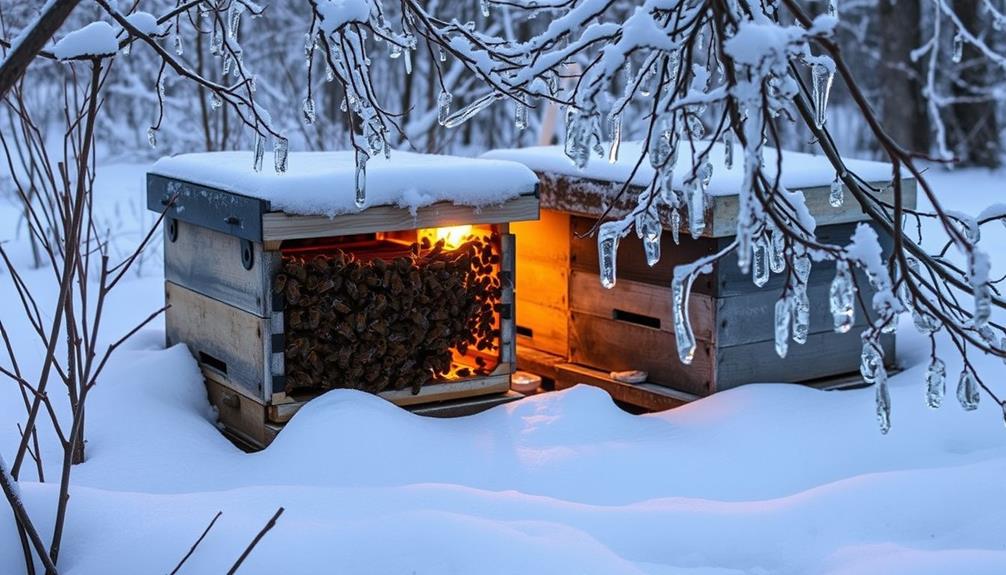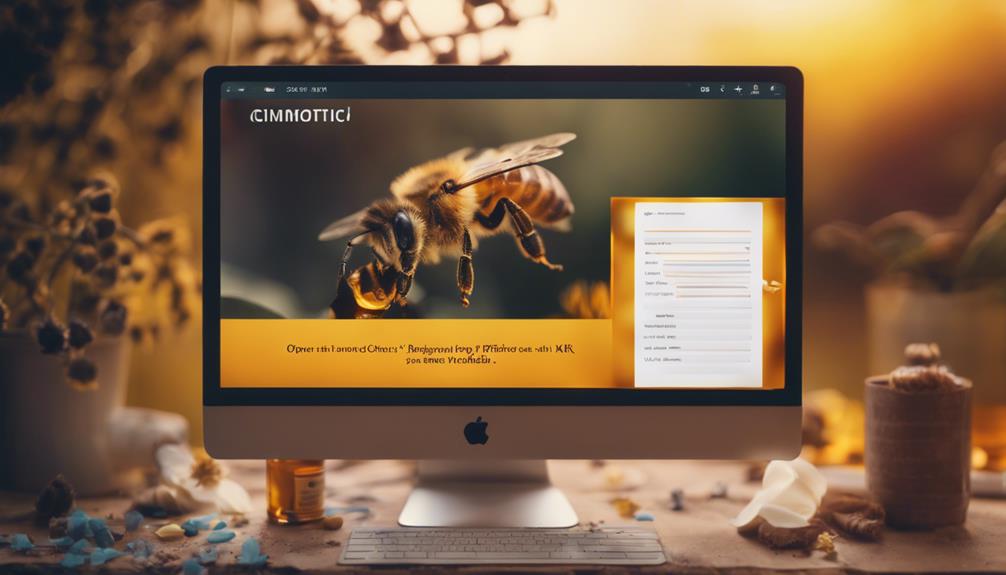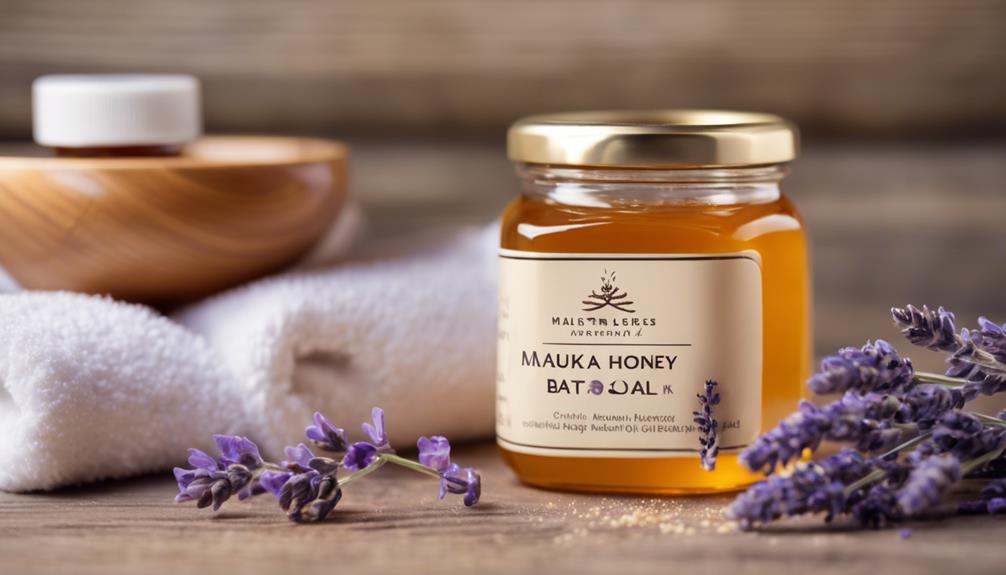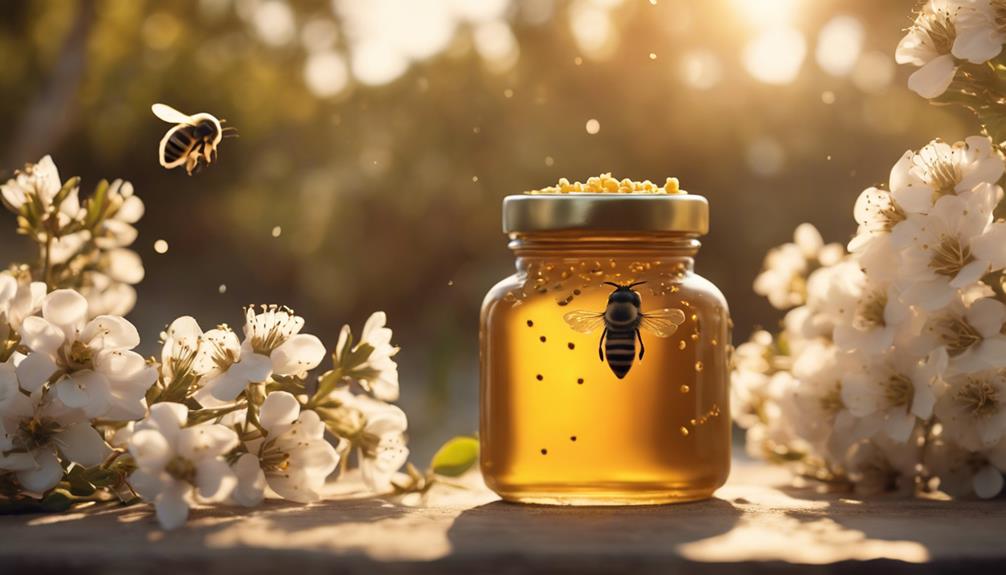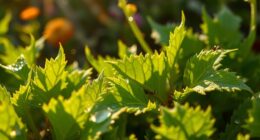Beekeeping photography lets you capture the stunning beauty of beehives and the fascinating journey of honey. You'll want to use natural light to highlight vibrant colors and textures, especially during early mornings or late afternoons. Consider investing in a macro lens for detailed close-ups and experiment with angles to showcase the bees' natural behaviors. Documenting the honey harvest can add depth to your visual story, from uncapping honeycomb to the extraction process. This art not only celebrates nature but raises awareness about bees' essential roles in our ecosystem. There's much more to explore in this enchanting field.
Key Takeaways
- Beekeeping photography showcases the intricate beauty of bees and their vital role in ecosystem health through captivating images of beehives and honey production.
- Utilizing macro photography techniques allows for detailed close-ups of bees and honeycomb, revealing their unique features and behaviors.
- Proper lighting and composition enhance the visual appeal, with natural light and dynamic angles creating striking images of bee activities and their environment.
- Documenting the honey extraction process educates the public about honey's journey, highlighting the craftsmanship involved in harvesting.
- Photography serves as a powerful advocacy tool to raise awareness about declining bee populations and promote conservation efforts.
Importance of Beekeeping Photography

Beekeeping photography plays an essential role in showcasing the beauty and complexity of bee life. By capturing the intricate details of hives and bees, these images highlight their significant role in pollination and honey production, which are critical for ecosystem health. The fascinating diversity of bee species, such as the Western Honey Bee, further emphasizes the importance of these creatures in our environment.
When you see stunning photographs of bee colonies, it raises awareness about the declining bee populations, encouraging conservation efforts and sustainable practices in beekeeping.
Moreover, photographs documenting the honey extraction process showcase the craftsmanship involved, educating the public about the journey of honey from hive to table. This visual storytelling can inspire new generations to engage in beekeeping, fostering a community dedicated to environmental stewardship.
The more people understand the importance of bees, the more likely they're to support practices that protect them.
High-quality images serve multiple purposes. You can use them in educational materials to inform others and in marketing to enhance the visibility of local honey producers. By supporting small-scale agriculture, you contribute to a sustainable future.
Ultimately, beekeeping photography isn't just art; it's a powerful tool for advocacy, education, and community building.
Techniques for Capturing Bees

When you're capturing bees, lighting plays an essential role in showcasing their vibrant colors and details.
Understanding the various brewing methods involved in coffee can inspire creative backgrounds for your photography.
Using macro photography techniques lets you zoom in on their intricate features, while thoughtful composition can elevate your images.
Ideal Lighting Conditions
Capturing stunning images of bees hinges on finding the right lighting conditions. Early morning and late afternoon are your best bets, as the softer, golden hues enhance the details and colors of the bees and their surroundings.
This is similar to the radiant and heartwarming essence captured in songs like Blue Skies and Lemonade, which evoke feelings of joy and nostalgia. On overcast days, you'll find that the clouds diffuse sunlight, reducing harsh shadows and providing even light that beautifully highlights the bees without glare.
When using a macro lens, you can get up close to reveal intricate details in their bodies and wings; ideal lighting makes these features pop.
Experiment with your position relative to the light source. For instance, backlighting can create striking effects, illuminating the wings of bees as they fly or rest on flowers.
If you encounter darker areas, consider using reflectors to bounce natural light onto the bees. This technique enhances visibility and detail without relying on artificial lighting.
Macro Photography Tips
Mastering macro photography techniques can greatly elevate your ability to photograph bees in stunning detail.
By using the right gear and settings, you can capture the intricate beauty of these fascinating creatures without disturbing their natural behavior.
Here are three essential tips to help you get started:
- Use a Macro Lens: Opt for a macro lens with a focal length of 100mm or higher. This allows you to get close-up shots of bees and honeycomb structures while keeping a comfortable distance, minimizing disruption.
- Set a Wide Aperture: Choose a wide aperture (f/2.8 to f/5.6) for a shallow depth of field. This isolates your subjects, creating a beautiful bokeh effect that highlights the bees against their surroundings.
- Stabilize Your Shot: Use a tripod or stabilizer to reduce camera shake, particularly at slower shutter speeds. This guarantees you capture sharp images, vital in macro photography.
Composition and Framing
Creating compelling compositions is essential for showcasing the beauty and complexity of bees in their natural habitat. Start by using natural light to highlight the intricate details of bee behavior and hive structure. This light enhances textures and colors, making your images pop.
Frame your shots to include both close-ups of individual bees and wider angles that capture the entire hive. This provides context to their activities and emphasizes their role in the ecosystem.
Incorporate elements of the surrounding environment, like flowers or plants, to create a sense of place, illustrating the pollination relationship. A shallow depth of field can focus on specific bees or honeycomb patterns, allowing for striking contrasts against a blurred background that draws viewers in.
Don't hesitate to change your perspective; shoot from above or below the hive to create dynamic compositions that showcase the complexities of bee colonies. Experimenting with different angles can reveal unique aspects of their world, making your photographs not just visually appealing but also informative.
Essential Equipment for Photographers

When you're venturing into the world of beekeeping photography, having the right equipment makes all the difference.
You'll want to invest in gear that allows you to capture the beauty and detail of beehives and honey. Here are three fundamental items to take into account:
- DSLR or Mirrorless Camera: A high-quality camera is essential for achieving excellent image quality and flexibility with lenses. This will enable you to shoot both close-ups and wider scenes effectively.
- Macro Lens: Look for a macro lens with a focal length of 100mm or more. This will help you take stunning close-up shots of bees and honeycombs, showcasing intricate details that are often missed by the naked eye.
- Sturdy Tripod: A tripod is critical for stabilizing your camera, especially during low-light conditions like early mornings or late afternoons when bees are most active. It guarantees sharp images even in challenging lighting.
These tools won't only enhance your photography but also allow you to appreciate the delicate world of bees and their habitats.
Be prepared to capture their beauty with the right equipment!
Creative Composition Ideas

When you're photographing beehives, try capturing them from unique angles to highlight their intricate textures.
Macro photography can also bring out the stunning details of bees in action, revealing their beauty and the art of honey production.
Unique Perspectives on Beehives
Often, unique perspectives on beehives can transform your photography from ordinary to extraordinary. By experimenting with different angles and compositions, you can capture the beehive's beauty in ways that truly stand out.
Here are three creative ideas to enhance your shots:
- Shoot from Below: Position yourself beneath the hive to capture the intricate details of the entrance. This angle showcases the bustling worker bees as they enter and exit, offering a dynamic view of their daily activities.
- Play with Lighting: Utilize natural light during sunrise or sunset for dramatic silhouettes. Backlighting not only highlights the hive but also accentuates the golden hues of honey, creating a warm and inviting atmosphere.
- Incorporate Surroundings: Frame the beehive with vibrant flowers or lush greenery. This contrast emphasizes the crucial relationship between bees and their environment, adding depth to your images.
Macro Photography Techniques
How can you elevate your macro photography of bees and beehives? Start by using a macro lens with a focal length of 100mm or more. This allows you to capture intricate details, showcasing the textures and patterns of bees and honeycomb structures. Experiment with apertures between f/2.8 and f/5.6 to achieve a shallow depth of field, creating a striking bokeh effect that emphasizes your subject.
Natural light is your friend. Shoot during early morning or late afternoon to take advantage of the golden hour, enhancing the colors and warmth of your images. To maintain sharp focus, use a tripod or stabilizing equipment, especially when capturing fast-moving bees.
Lastly, consider your composition. Implement the rule of thirds or leading lines to draw the viewer's eye toward your subject. Here's a quick reference table for your macro photography techniques:
| Technique | Description | Tips |
|---|---|---|
| Macro Lens | Use 100mm+ for detail | Captures intricate textures |
| Aperture | f/2.8 to f/5.6 for bokeh | Isolates subject from background |
| Lighting | Shoot during golden hour | Enhances colors and warmth |
| Stability | Use a tripod or stabilizing equipment | Reduces camera shake |
| Composition | Apply rule of thirds or leading lines | Engages the viewer |
Showcasing the Honey Harvest

Capturing the honey harvest is a rewarding experience, allowing you to showcase the beauty and intricacy of the process.
You'll want to highlight the various stages of honey extraction, from the moment you remove the honeycomb from the hive to the final product ready for sale.
To make your photography compelling, focus on these key aspects:
- Uncapping the Honeycomb: Photograph the beekeeper delicately uncapping the honeycomb, revealing the golden treasure inside. This moment emphasizes the skill involved in the harvest.
- Centrifugation in Action: Capture the spinning frames in the centrifuge, where honey separates from the wax comb. This dynamic process illustrates the efficiency and technology behind honey extraction.
- Filtering for Purity: Document the filtering stage, where honey is purified. Showcasing the clear, golden liquid flowing through filters highlights the care taken to guarantee quality.
As you snap these shots, pay attention to the details—the glistening honey, the rustic tools, and the beekeeper's craftsmanship.
Each image tells a story of dedication and the natural beauty of honey harvesting.
Inspiring Environmental Awareness

Inspiring environmental awareness through beekeeping photography not only highlights the beauty of these industrious insects but also emphasizes their crucial role in our ecosystem. As you capture the intricate details of bee colonies, you're reminding others that honey bees pollinate about one-third of the food crops we consume. This critical service supports biodiversity and maintains ecosystem health.
However, the decline in bee populations poses a serious threat due to habitat loss, pesticides, and diseases. By engaging with educational initiatives around beekeeping, you promote community involvement and share knowledge about the interconnectedness of agriculture and conservation.
Here's a quick overview of the impact of beekeeping photography:
| Aspect | Importance | Action Required |
|---|---|---|
| Pollination | Supports food production | Advocate for sustainable practices |
| Biodiversity | Maintains ecosystem balance | Promote bee-friendly habitats |
| Community Engagement | Fosters awareness and education | Organize workshops and events |
Frequently Asked Questions
What Are the Best Times of Day for Beekeeping Photography?
For beekeeping photography, early morning and late afternoon are your best times. The soft, golden light enhances details and reduces harsh shadows, making your images of bees and hives truly enchanting and vibrant.
How Can I Safely Approach a Bee Hive for Photos?
To safely approach a bee hive for photos, wear protective gear, stay calm, and move slowly. Observe the bees' behavior, and maintain a respectful distance to avoid alarming them while capturing their beauty.
Are There Specific Bee Species to Focus on in Photography?
You'd think all bees are photogenic, right? Focus on honeybees for their vibrant colors and social antics, bumblebees for their fluffiness, and mason bees for their unique nests. They're nature's little stars, after all!
What Ethical Considerations Should Photographers Keep in Mind?
When photographing nature, you should respect wildlife and their habitats. Avoid disturbing animals, maintain a safe distance, and consider the impact of your presence. Always prioritize conservation, ensuring your work doesn't harm the environment or its inhabitants.
Can I Use a Smartphone for Beekeeping Photography Effectively?
You can capture stunning beekeeping images with your smartphone. Its portability and advanced camera features make it a fantastic tool. Just remember to focus on lighting and angles, and you'll get amazing shots!
Conclusion
In the world of beekeeping photography, you've got the chance to make a buzzing impact. By capturing the intricate beauty of beehives and the golden allure of honey, you not only celebrate nature but also inspire others to appreciate and protect it. Remember, "a picture is worth a thousand words," and your images can tell the essential story of bees and their important role in our ecosystem. So grab your camera and start snapping; the bees need you!

